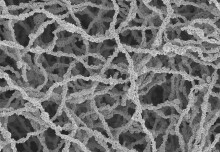

The John Adams Institute for Accelerator Science is expanding, with a new base at Imperial joining two existing centres at Royal Holloway and Oxford
The John Adams Institute for Accelerator Science (JAI) is expanding, with a new research base at Imperial College London joining two existing centres at Royal Holloway, University of London and the University of Oxford.
See also:
Related news stories:
 Scientists at the Institute are researching ways to improve particle accelerator technology and its applications in science and medicine. New funding from the UK government's Science and Technology Facilities Council (STFC) will help accelerator science develop beyond its current use for research in fundamental physics like the hunt for new bosons at the Large Hadron Collider.
Expertise at Imperial will now help to develop advanced medical treatments, such as new forms of cancer radiotherapy that avoid damaging tissue surrounding a tumour. Future developments would help to reduce the size and cost of these machines, making them accessible for use in smaller hospitals or research centres.
Professor Zulfikar Najmudin, JAI's deputy director and Professor of Physics at Imperial College London, said: "The JAI now connects the world-leading efforts on laser plasma acceleration which were developed in Imperial's Plasma Physics group and Oxford's Atomic and Laser group, and enhanced by the traditional strength of JAI in laser-beam expertise, and creates new opportunities for developments of laser plasma acceleration applications and new instruments, in particular compact X-ray light sources."
Professor Maggie Dallman, Principal of the Faculty of Natural Sciences at Imperial College London, and member of the JAI Governing Board, said: "With JAI established in Imperial we are looking forward, in collaboration with our two excellent university partners, to enhancing our activities toward development of application based on our innovative research in accelerator, plasma and laser physics as well as boost our industrial connections."
Professor John Womersley, Chief Executive of the STFC said "We support the JAI because of the importance that we place on accelerator R&D and the Institute's world-class capabilities. The expansion of the Institute to include Imperial College London will not only strengthen the collaboration between leading UK universities, with a focus in developing new laser-based accelerators, but will also lead to novel applications areas and help to attract and train the next generation of accelerator scientists and engineers."
The JAI was created in October 2004 initially as a joint venture between the Departments of Physics in the University of Oxford and Royal Holloway, University of London.
Â

A research team from the newly formed Imperial division of the John Adams Institute for Accelerator Science working on an experiment on the Gemini High Power Laser Facility at the Rutherford-Appleton Laboratory
Article text (excluding photos or graphics) available under an Attribution-NonCommercial-ShareAlike Creative Commons license.
Photos and graphics subject to third party copyright used with permission or © Imperial College London.
Reporter
Simon Levey
Communications Division

Contact details
Email: s.levey@imperial.ac.uk
Show all stories by this author




Leave a comment
Your comment may be published, displaying your name as you provide it, unless you request otherwise. Your contact details will never be published.